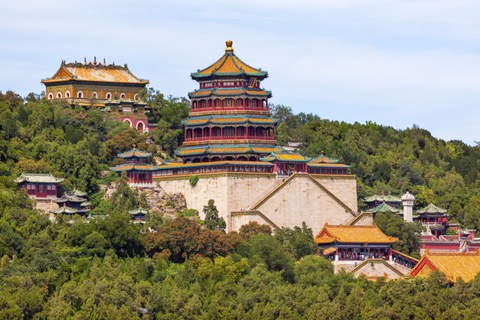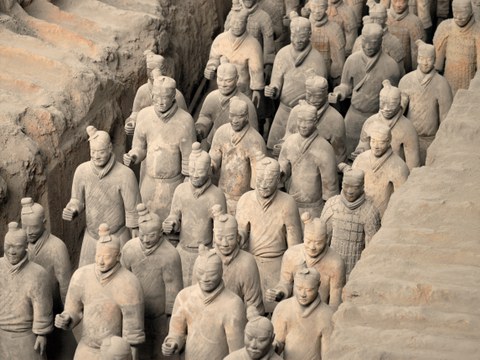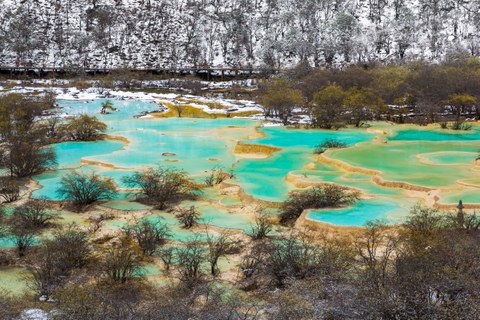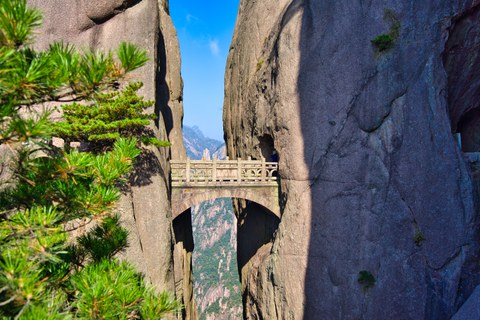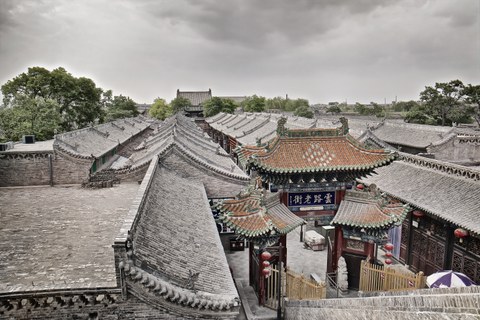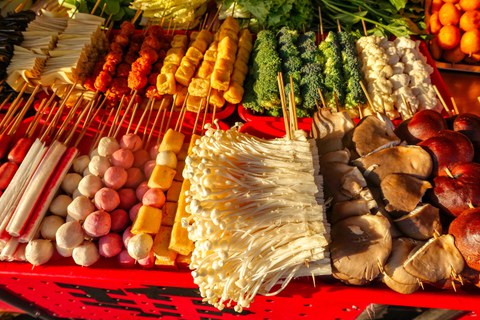Partner Country of the Month February 2022: People's Republic of China
Just in time for the beginning of the Year of the Water Tiger, we turn our gaze eastward in February - to China! The New Year is considered the most important Chinese holiday, although it is actually a whole week of celebrations. China is very rich in traditions and history, the traces of which are reflected in many parts of East Asia. As an important economic power and the country with the largest population in the world, it also plays a significant global role. We would like to share a few impressions of this incredibly diverse country with you here.
With the "Partner Country of the Month" campaign, we want to shine a spotlight on the wide diversity of countries, regions and partner universities of TU Dresden that our students can explore during a semester abroad.
Table of contents
General facts and figures about China
Capital: Beijing
Population: 1.411.780.000 (2020)
Official languages: Mandarin and officially recognized regional languages
National holiday: October 1 (Foundation of the People's Republic of China)
Currency: Renminbi / Chinese Yuan (元)
You can find further facts, figures and information on wikipedia, on China.org, or e.g. on Gov.cn.
Language matters
- Hello - 你好 Nǐ hǎo
- How are you? - 你好吗? Nǐ hǎo ma?
- My name is ... - 我姓 ... Wǒ xìng ...
- How much is this? - 多少钱? Duō shao qián?
- Thank you - 谢谢 Xièxie
- Bye - 再见 Zàijiàn
There are over 300 different dialects and languages spoken in China. Since the 1980s, Mandarin Chinese has been the official language taught throughout the country. English is only common in larger cities among younger people.
The Chinese character system is one of the oldest in the world. The first characters were found carved in so-called bone oracles from around 1600 to 1000 BCE. It is the only writing system of antiquity that is still in use today. Pinyin, the transcriptions of the character sounds into the Latin alphabet, help those who cannot read Chinese.
The rumor persists that Chinese is difficult to learn. There is certainly some truth in this, especially when it comes to the writing system. Chinese characters are not based on the reproduction of uniform sounds, but refer to semantic elements (the representation of concepts and meaning). Therefore, the Chinese writing system has about 100.000 characters. However, many of them are no longer in use, so that most texts can be understood well with the knowledge of 2.500 to 5.000 characters. While writing Chinese is complex, other aspects like the relatively simple grammar are easier to learn.
If you would like to know more about the Chinese language or would like to learn it, you are welcome to take a look at TUDIAS or attend courses at the Volkshochschule.
In order to be able to study the People's Republic of China in more detail, there are various support programs and scholarships through which you can gain authentic impressions of the country and its people. The following are just a few examples:
- Bildungsbrücke MINT
- Sprache und Praxis in der VR China (DAAD Scholarship)
Did you know that ....?
- laughter is an important means of communication in China? Chinese people often laugh even in situations where it might seem unusual or inappropriate in a German cultural context. It does not necessarily mean that the person is having fun, but is meant to help relax the discourse.
- in China, very great importance is attached to table manners? While there is no need to be embarrassed about slurping and eating noisily, pay attention to some Chinese rules. For example, take care to use chopsticks correctly (do not stick them vertically into your rice - this resembles a funeral ritual) and be careful not to leave any rice in your bowl. Also, do not refuse food or drinks offered - that is considered a mark of ignorance.
-
Dresden has a twin city in China since 2009? In the Middle Ages, Hangzhou was already considered the "greatest city in the world" in Marco Polo's description, and today it is an important economic center, producing green tea and silk, among other things. European flair can also be found: In a suburb of the city, parts of Paris have been recreated, so that you can visit the Eiffel Tower and the Arc de Triomphe there.
-
in Chinese hotels, rooms with the number 4 usually do not exist? The number 4 is pronounced in a similar way to the Chinese word for "death" and is therefore an unlucky number. Similarly, the word for "shoe" sounds like "unhealthy" or "bad", so you should avoid buying new shoes during the New Year's days in order not to scare away good luck for the New Year. The color red, on the other hand, is considered lucky.
Cooperation with TU Dresden
You can find all cooperations of TU Dresden in our database. Have a look at the experiences of our previous exchange students at Questionnaires. Professors at your faculty may have direct contacts to your partner university of choice and can advise you.
Cooperations of TU Dresden with Chinese universities
- Faculty cooperation - Business Administration and Economics
- Interdisciplinary cooperation via TUDworldwide
- Zhejiang University in Hangzhou
- all faculties except medicine
Don't miss...
Xi'an is one of the oldest cities in China and was once the starting point of the Silk Road. Today, it is famous for the Terracotta Army that was discovered here. More than 7,000 clay soldiers guard the tomb of China's first emperor, and all of them have individually designed uniforms and facial features. Also worth seeing is the city's Muslim quarter in with its mosque and oriental market.
Huanglong. This natural park is also called a wonder or fairytale land, and has been declared a UNESCO World Heritage site in 1992. A multitude of limestone terraces create hundreds of pools with breathtaking turquoise waters. Huanglong means golden dragon - the name derives from the fact that the travertine terraces look like a giant golden dragon from above, winding its way through the forested mountains.
The Bridge of the Immortals. The Huangshan Mountains ("Yellow Mountains") are the real-world inspiration for the iconic depiction of mountains in Chinese paintings. Here you can also find the world's highest bridge, 1320m above sea level. Until 1987, locals used to cross the precipice via a dangerous suspension bridge, where many fell to their deaths. The current bridge is safe for pedestrians. If you dare to brave the heights, you will be rewarded with a spectacular view of the unique stone formations of the Huangshan.
Pingyao. If you want to experience historical China, you should take a trip to Pingyao. The cityscape has hardly changed for 700 years and gives an excellent impression into the Ming era, with a completely preserved city wall and a multi-level market tower.
Zhangjiajie National Park. If you think of the science fiction film "Avatar" when looking at the delicate karst pillars of Zhangjiajie, you are not mistaken. They are said to have served as inspiration for the landscape of the fictional Earth-like moon Pandora. Other highlights of the park include waterfalls, dense primeval forests, karst caves with impressive flora and fauna, and the Zhangjiajie Grand Canyon, which can be crossed via a glass-bottomed suspension bridge.
Street Food in Beijing. Night markets and food streets are becoming increasingly popular not only among locals but also among visitors to Chinese cities. Here you can get typical snacks at a reasonable price, try exotic dishes and get an authentic insight into Chinese cuisine. Take a look at the huge Wangfujing Food Market, which is open 24 hours a day, or make a detour to Qianmen Food Street, where you can also find numerous tea houses and try the Wu Yu Tai ice cream with interesting varieties like matcha or jasmine tea.
Let's get cooking...
Chinese cuisine is characterized by strong regional differences. According to a proverb, the north has salty food, the south is more sweet, the west prefers sour, and the east likes it spicy. While the north also has Mongolian influences and has many cereals on the menu, the south uses a lot of sugar cane.
Surely everyone is familiar with the dish "Peking duck". Otherwise, Chinese cuisine has brought us tofu, soy sauce and green tea, among other things. Dairy products are rather rare in China, which is also due to the fact that a large part of the population is lactose intolerant. In general, many animal ingredients are used in China and fish and meat are often on the menu. For vegetarians and vegans, Buddhist or Daoist cuisine is therefore recommended.
Dim Sum
Spain has tapas, Italy has antipasti, and China has dim sum. The dish originated in Cantonese cuisine, but is now eaten everywhere in China, with many variations. Dim sum means "appetizers that warm the heart". Depending on the preparation method, they can be eaten at any time of the day, from breakfast to afternoon tea time to a midnight snack.
The most famous version are dim sum "har gau", dumplings with a shrimp filling. You can find a recipe at EatSmarter!. This is just one way to prepare dim sum - you can find many more variations at The Spruce Eats. Moreover, the videos of Dianxi Xiaoge offer great visual impressions of Chinese cuisine for inspiration.
Contact
Have you had a great time in China? Do you have tips for places and experiences that are not to be missed? We would be happy to share your experiences here, on social media or, if you want, in information events for other TUD students. Get in touch with us:
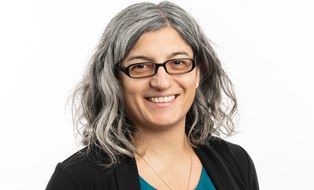 © Sven Ellger/TUD
© Sven Ellger/TUD
Advice on studying abroad
NameMs Federica Serra
Infocenter/ Study abroad; TUDworldwide: America
Send encrypted email via the SecureMail portal (for TUD external users only).
Visiting address:
Fritz Foerster Bau, Office 161 Mommsenstraße 6
01069 Dresden
Postal address:
TUD Dresden University of Technology International Office
01062 Dresden
Office hours:
- Tuesday:
- 09:30 - 11:30
- 12:30 - 14:30
- Thursday:
- 09:30 - 11:30
Please register at the SCS (FOE, floor 0).
Looking for first-hand information?
Would you like to know more about China? Ask our alumni ambassadors - TUD alumni who are active in many countries around the world and can give you information and advice for your stay abroad.
Getting in touch is very easy: On this interactive world map, markers indicate the cities where our alumni ambassadors live. There is a short profile with contact information for each ambassador.
Partner Countries Archive
Have you missed a partner country? No worries! Here you can read up on all articles.
|
Europe (Erasmus+) |
|
|
Africa |
|
|
America |
|
|
Asia |
|
|
Australia and Oceania |
|


